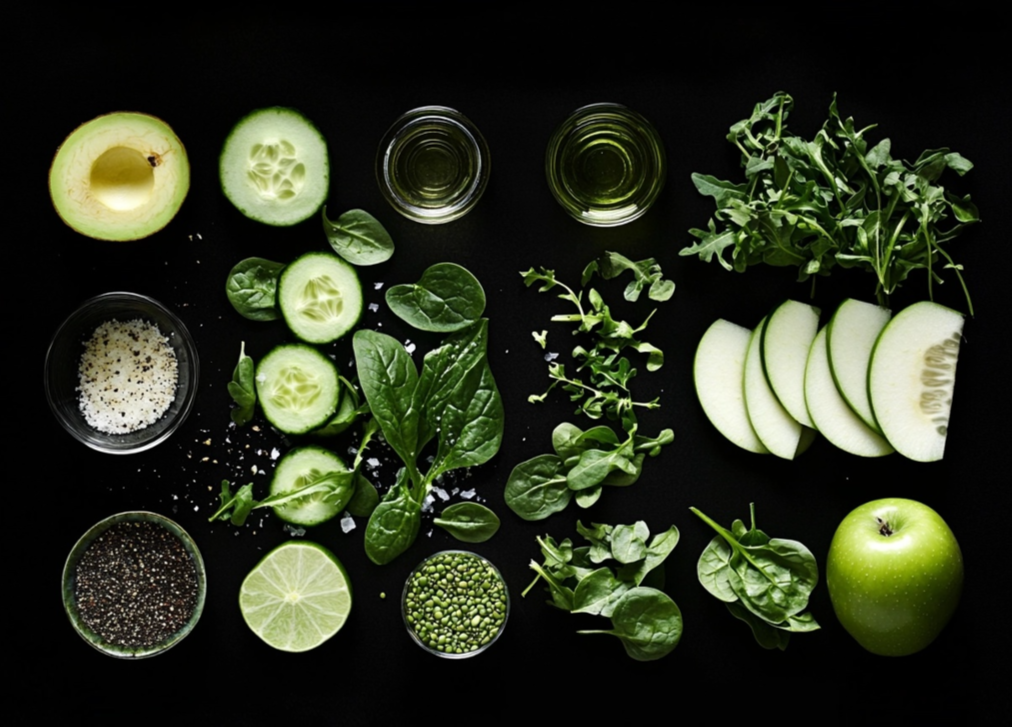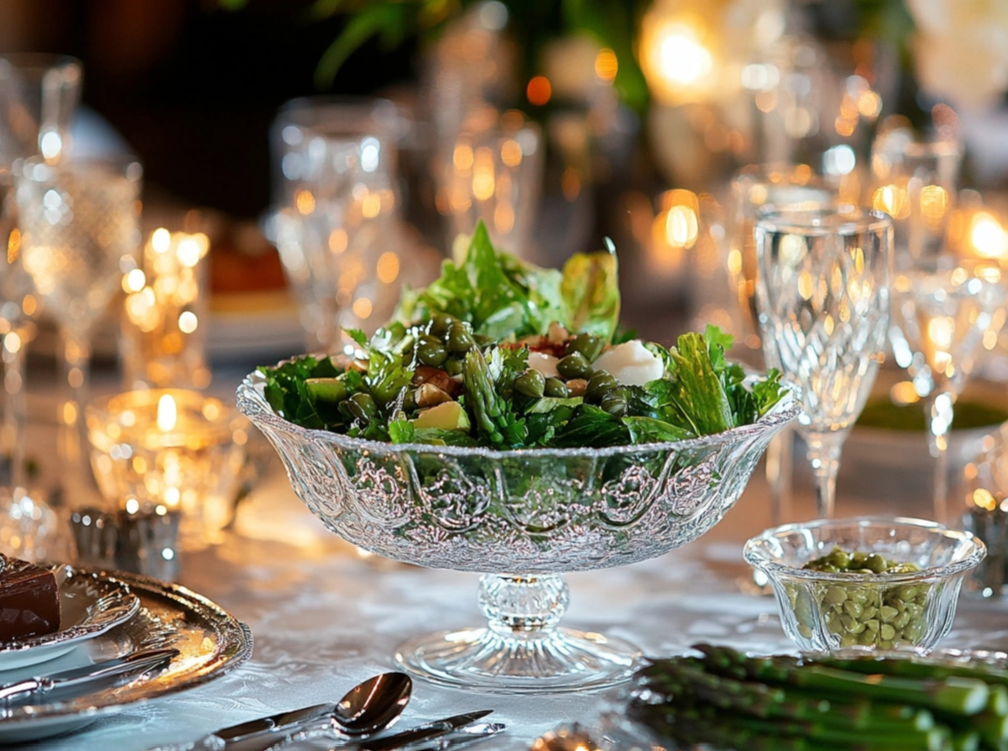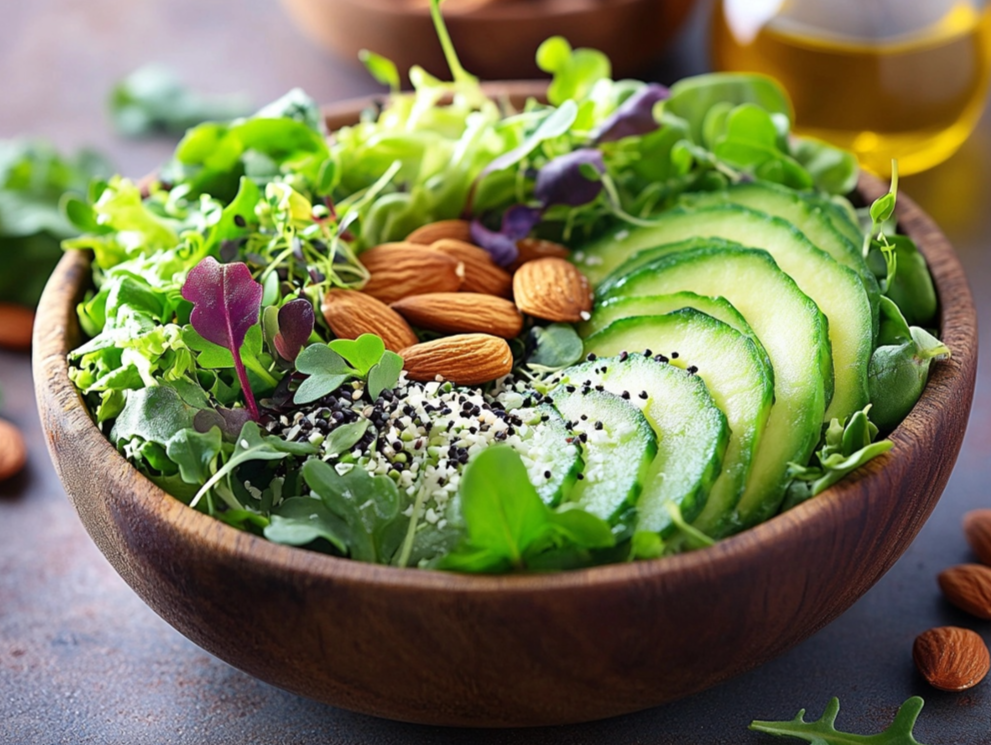Green Salad Recipes: Fresh and Nutritious Ideas
Explore our Green Salad Recipes. Delicious, healthy, and perfect for any meal.
Introduction to Green Salad Recipes
Green Salad Recipes offer a refreshing and nutritious option for any meal. These Green Salad Recipes are packed with fresh vegetables, vibrant greens, and flavorful toppings. Whether you’re looking for a light lunch, a hearty dinner side, or a healthy snack, Green Salad Recipes provide endless possibilities. Moreover, they cater to various dietary needs, making them suitable for everyone. Discover how to create delicious and varied salads that cater to all tastes and dietary needs.
Benefits of Green Salad Recipes
Choosing Green Salad Recipes comes with numerous benefits. Green Salad Recipes are not only delicious but also incredibly healthy, providing essential vitamins and minerals. Furthermore, they are versatile, allowing you to customize ingredients to suit your preferences. Additionally, Green Salad are easy to prepare, making them an excellent choice for busy lifestyles. Consequently, incorporating these salads into your diet can help you maintain a balanced and nutritious meal plan.
Nutritional Advantages
Green Salad Recipes are packed with nutrients that support overall health. Leafy greens like spinach, kale, and arugula provide vitamins A, C, and K, as well as iron and calcium. Moreover, fresh vegetables add fiber, which aids in digestion and promotes a feeling of fullness. Additionally, healthy fats from ingredients like avocado, nuts, and olive oil enhance the absorption of fat-soluble vitamins. Therefore, by incorporating Green Salad Recipes into your meals, you ensure a well-rounded intake of essential nutrients.
Convenience and Versatility
One of the key benefits of Green Salad Recipes is their convenience. Green Salad Recipes can be prepared quickly, making them ideal for busy mornings, lunches, or dinners. They are highly versatile, allowing you to experiment with different ingredients and dressings to keep your salads exciting and flavorful. Whether you prefer a simple mix of greens or a more elaborate combination of toppings, Green Salad can be tailored to fit any occasion and taste preference. Consequently, you can enjoy a fresh and tasty salad without spending too much time in the kitchen.
Essential Ingredients for Green Salad Recipes
Creating the perfect Green Salad Recipes requires selecting the right ingredients. High-quality, fresh produce forms the foundation of any delicious salad. Below are the essential components:
- Leafy Greens: Spinach, kale, arugula, romaine, and mixed greens.
- Vegetables: Cucumbers, tomatoes, bell peppers, carrots, and red onions.
- Proteins (optional): Grilled chicken, tofu, chickpeas, or hard-boiled eggs.
- Healthy Fats: Avocado, nuts, seeds, and olive oil.
- Dressings: Vinaigrettes, creamy dressings, or homemade sauces.
- Toppings: Cheese, croutons, dried fruits, and fresh herbs.

Choosing the Right Greens for Green Salad Recipes
The type of greens you select can significantly impact the flavor and texture of your Green Salad. Green Salad Recipes benefit from using a variety of leafy greens to add depth and complexity. For a tender texture, choose spinach or butter lettuce. Conversely, for a more robust flavor, opt for kale or arugula. Mixing different greens not only enhances the taste but also boosts the nutritional value of your salads. Therefore, experimenting with various greens can lead to more satisfying and healthful Green Salad Recipes.
Selecting Fresh and Seasonal Vegetables for Green Salad Recipes
Using fresh and seasonal vegetables is crucial for creating vibrant and tasty Green Salad Recipes. Fresh vegetables provide the best flavor and texture, while seasonal produce ensures that your salads are at their peak in terms of taste and nutrition. Incorporate a mix of crunchy and soft vegetables to add variety and interest to your salads. Additionally, choosing organic vegetables when possible can enhance the quality and health benefits of your Green Salad. Thus, prioritizing freshness and seasonality can elevate the overall quality of your salads.
Step-by-Step Guide to Making Green Salad Recipes
Creating Green Salad Recipes is straightforward with the right steps. Follow this comprehensive guide to make delicious and nutritious salads every time.
1. Gather Your Ingredients
Start by gathering all the necessary ingredients for your Green Salad Recipes. Ensure you have a variety of fresh greens, vegetables, proteins, and your preferred dressings. Having all ingredients ready makes the preparation process smooth and efficient.
2. Prepare the Greens
Wash and dry your leafy greens thoroughly. Spin them in a salad spinner or pat them dry with a clean kitchen towel to remove excess moisture. Dry greens help the dressing adhere better and prevent your salad from becoming soggy. Consequently, ensuring your greens are properly prepared is essential for a crisp and fresh salad.
3. Chop the Vegetables
Chop your vegetables into bite-sized pieces. Uniform chopping ensures even distribution of flavors and makes the salad more visually appealing. Consider using a mix of colors and textures to create a vibrant and interesting Green Salad Recipes. Moreover, varying the sizes of your vegetable cuts can add an appealing aesthetic and enhance the eating experience.
4. Add Proteins and Healthy Fats
If you’re adding proteins like grilled chicken, tofu, or chickpeas, prepare them ahead of time. Slice or cube the proteins and evenly distribute them over the salad. Incorporate healthy fats by adding avocado slices, nuts, or seeds, which enhance the flavor and nutritional profile of your Green Salad Recipes. Therefore, including proteins and healthy fats can make your salad more satisfying and nutritionally balanced.
5. Toss the Salad
Combine all the ingredients in a large bowl. Gently toss the salad to ensure all components are evenly distributed. Be careful not to over-toss, as this can cause the greens to wilt and the vegetables to become mushy. Additionally, using salad tongs can help you toss the ingredients more effectively without damaging the delicate greens.
6. Add the Dressing
Drizzle your preferred dressing over the salad. Start with a small amount and add more as needed to avoid overpowering the flavors. Toss the salad again to coat all the ingredients evenly with the dressing. Consequently, controlling the amount of dressing ensures that your Green Salad Recipes remain fresh and flavorful without becoming soggy.
7. Garnish and Serve
Garnish your Green Salad Recipes with additional toppings like cheese, croutons, or fresh herbs for an extra burst of flavor and texture. Serve immediately to enjoy the freshness and crunch of your salad. Additionally, presenting your salad in an appealing manner can make it more inviting and enjoyable.

Variations and Customizations of Green Salad Recipes
Green Salad Recipes are incredibly versatile. You can customize them to suit your taste preferences and dietary needs. Here are some popular variations:
Mediterranean Green Salad Recipes
Mediterranean-style Green Salad Recipes incorporate ingredients like feta cheese, olives, cucumbers, tomatoes, and red onions. Dress the salad with a lemon-oregano vinaigrette for a tangy and herbaceous flavor. This variation is perfect for those who enjoy bold and vibrant flavors. Moreover, the inclusion of Mediterranean staples adds a delightful complexity to your salads.
Protein-Packed Green Salad Recipes
For a more filling and nutritious meal, add proteins like grilled chicken, shrimp, tofu, or hard-boiled eggs to your Green Salad Recipes. Incorporate beans or lentils for an extra boost of plant-based protein. This variation makes your salad a complete and satisfying meal. Additionally, the added proteins can help keep you energized and full for longer periods.
Vegan Green Salad Recipes
Creating vegan Green Salad Recipes is easy by omitting animal-based ingredients and focusing on plant-based proteins and toppings. Use ingredients like chickpeas, tofu, avocado, nuts, and seeds. Dress the salad with a tahini-based or citrus vinaigrette to keep it flavorful and vegan-friendly. Consequently, vegan Green Salad Recipes can be both delicious and inclusive for various dietary preferences.
Low-Carb Green Salad Recipes
For those following a low-carb diet, focus on high-fat and protein-rich toppings while minimizing starchy vegetables. Incorporate ingredients like avocado, cheese, nuts, seeds, and grilled meats. Use a creamy dressing made with olive oil and vinegar to enhance the flavors without adding extra carbohydrates. Therefore, low-carb Green Salad Recipes can provide a satisfying and health-conscious meal option.
Tropical Green Salad Recipes
Add a tropical twist to your Green Salad Recipes by incorporating fruits like mango, pineapple, and papaya. Combine these with ingredients like red bell peppers, cucumbers, and fresh herbs. Dress the salad with a sweet and tangy dressing made from lime juice and honey for a refreshing and vibrant option. Moreover, the addition of tropical fruits can infuse your salads with natural sweetness and exotic flavors.
Tips and Tricks for Perfect Green Salad Recipes
To ensure your Green Salad Recipes turn out perfectly every time, consider the following tips and tricks:
1. Use Fresh Ingredients
The key to a delicious Green Salad Recipes is using the freshest ingredients possible. Fresh greens and vegetables provide the best flavor and texture, making your salad more enjoyable and nutritious. Furthermore, fresh ingredients are more likely to retain their vibrant colors and crispness, enhancing the overall appeal of your salads.
2. Balance Flavors and Textures
Aim for a balance of flavors and textures in your Green Salad Recipes. Combine crunchy vegetables with creamy toppings and add a mix of sweet, savory, and tangy elements to create a well-rounded and satisfying salad. Consequently, achieving this balance can make your salads more interesting and enjoyable to eat.
3. Properly Season Your Salad
Seasoning is essential for enhancing the flavors of your Green Salad Recipes. Sprinkle a bit of salt and pepper over the salad before tossing to ensure all the ingredients are well-seasoned. Additionally, consider adding herbs and spices to the dressing for extra flavor. Therefore, proper seasoning can elevate the taste of your salads and make them more delicious.
4. Don’t Overdress the Salad
Using too much dressing can make your salad soggy and overpower the flavors. Start with a small amount of dressing and add more as needed. Toss the salad gently to ensure even distribution without over-saturating the ingredients. Consequently, controlling the amount of dressing ensures that your Green Salad Recipes remain fresh and flavorful.
5. Prep Ingredients Ahead of Time
Preparing your ingredients ahead of time can make assembling Green Salad Recipes quick and easy, especially during busy weekdays. Chop vegetables, cook proteins, and prepare dressings in advance to streamline the process. Moreover, having prepped ingredients on hand allows you to create salads swiftly when hunger strikes.
6. Experiment with Different Dressings
Variety in dressings can significantly keep your Green Salad Recipes exciting and flavorful. For instance, try making your own dressings using ingredients like olive oil, vinegar, lemon juice, mustard, honey, and fresh herbs. Alternatively, experiment with different store-bought dressings to discover new flavor combinations that enhance your salads. Moreover, incorporating diverse dressings can complement the various ingredients in your Green Salad Recipes, thereby elevating the overall taste and presentation. Furthermore, trying dressings from different cuisines, such as Asian-inspired sesame dressings or Italian balsamic vinaigrettes, can introduce unique flavors that transform your salads into gourmet creations. Additionally, you might consider infusing your dressings with spices like paprika, cumin, or garlic powder to add an extra layer of depth and complexity. Ultimately, by diversifying your dressing options, you ensure that your Green Salad Recipes remain fresh, exciting, and full of varied flavors.
Frequently Asked Questions
How do you make green salad taste better?
Enhancing the flavor of your Green Salad Recipes is easy with a few simple techniques. Start by using fresh, high-quality ingredients for the best taste. Additionally, incorporate a variety of textures by adding crunchy vegetables, nuts, or seeds. Moreover, use a flavorful dressing, whether it’s a classic vinaigrette or a creamy dressing, to elevate the salad’s taste. Furthermore, adding proteins like grilled chicken, tofu, or beans can make the salad more satisfying and flavorful. Don’t forget to season with salt, pepper, and fresh herbs to enhance the overall flavor profile.
What is the most popular salad green?
The most popular greens used in Green Salad Recipes include:
- Romaine Lettuce: Crisp and refreshing, perfect for Caesar salads.
- Spinach: Tender and mild, great for versatile salads.
- Mixed Greens: A blend of various lettuces and arugula for a diverse texture.
- Kale: Robust and hearty, ideal for nutrient-dense salads.
- Arugula: Peppery and flavorful, adds a unique kick to any salad.
These greens are favored for their taste, texture, and nutritional benefits, making them staples in countless salad recipes.
What are the 5 basic types of salads?
The five basic types of Green Salad Recipes include:
- Garden Salad: A simple mix of fresh vegetables and greens, often served with a basic vinaigrette.
- Caesar Salad: Features romaine lettuce, croutons, Parmesan cheese, and Caesar dressing.
- Cobb Salad: A hearty salad with greens, proteins (like chicken or bacon), avocado, and hard-boiled eggs.
- Chef Salad: Includes a variety of greens, meats, cheeses, and vegetables, typically served with a creamy dressing.
- Greek Salad: Combines greens with tomatoes, cucumbers, olives, feta cheese, and a lemon-oregano dressing.
Each type offers a unique combination of ingredients and flavors, catering to different tastes and dietary preferences.
What is a green salad made of?
A typical Green Salad Recipes consists of:
- Leafy Greens: Such as spinach, kale, romaine, or mixed greens.
- Vegetables: Including cucumbers, tomatoes, bell peppers, carrots, and onions.
- Proteins (optional): Like grilled chicken, tofu, chickpeas, or hard-boiled eggs.
- Healthy Fats: Avocado, nuts, seeds, or olive oil.
- Dressings: Vinaigrettes, creamy dressings, or homemade sauces.
- Toppings: Cheese, croutons, dried fruits, and fresh herbs.
These components come together to create a balanced and nutritious meal that can be customized to suit individual tastes and dietary needs.
Enhancing Your Green Salad Recipes
Elevate your Green Salad Recipes with these enhancement tips. Enhancing your Green Salad Recipes involves using the right ingredients, experimenting with flavors, and incorporating new techniques to create a more complex and satisfying dish.
Adding Fresh Herbs and Spices
Incorporating fresh herbs and spices can significantly boost the flavor of your Green Salad Recipes. Green Salad Recipes pair well with herbs like basil, cilantro, mint, and dill. Additionally, spices such as paprika, cumin, and black pepper can add depth and complexity to the salad’s flavor profile. Therefore, experimenting with different combinations can help you discover your favorite seasoning blends and enhance the overall taste of your salads.
Incorporating Seasonal Fruits and Vegetables
Adding seasonal fruits and vegetables to your Green Salad Recipes can enhance their flavor and nutritional value. Ingredients like strawberries, apples, pears, or citrus fruits bring a sweet and tangy element to the salad. Similarly, seasonal vegetables like asparagus, beets, or Brussels sprouts add unique textures and flavors that complement the greens. Consequently, using seasonal produce can keep your salads interesting and aligned with the freshest ingredients available.
Using Variety of Textures
A mix of textures makes your Green Salad Recipes more interesting and enjoyable. Combine crunchy vegetables like bell peppers and cucumbers with softer elements like avocado or roasted vegetables. Adding nuts, seeds, or crunchy toppings like croutons provides a satisfying contrast to the tender greens. Therefore, balancing different textures can enhance the overall eating experience and make your salads more appealing.
Experimenting with Different Dressings
Variety in dressings can significantly keep your Green Salad Recipes exciting and flavorful. For instance, try making your own dressings using ingredients like olive oil, vinegar, lemon juice, mustard, honey, and fresh herbs. Alternatively, experiment with different store-bought dressings to discover new flavor combinations that enhance your salads. Moreover, incorporating diverse dressings can complement the various ingredients in your Salad, thereby elevating the overall taste and presentation. Furthermore, trying dressings from different cuisines, such as Asian-inspired sesame dressings or Italian balsamic vinaigrettes, can introduce unique flavors that transform your salads into gourmet creations. Additionally, you might consider infusing your dressings with spices like paprika, cumin, or garlic powder to add an extra layer of depth and complexity. Ultimately, by diversifying your dressing options, you ensure that your Salad remain fresh, exciting, and full of varied flavors.
Adding Proteins and Grains
Incorporating proteins and grains can turn your Green Salad Recipes into a more substantial meal. Add grilled chicken, shrimp, tofu, or beans for a protein boost. Incorporate grains like quinoa, farro, or brown rice to add fiber and make the salad more filling. These additions not only enhance the nutritional value but also add interesting textures and flavors. Consequently, your salads become more balanced and can serve as a complete meal option.
Incorporating Other Dishes for a Complete Meal
To create a well-rounded and satisfying meal, consider pairing your Green Salad Recipes with complementary dishes. For example, a side of Zucchini Pasta provides a low-carb, flavorful accompaniment that complements the freshness of the salad. Similarly, Avocado Toast with Feta offers a creamy and tangy addition, enhancing the overall dining experience. These pairings not only add variety but also ensure that your meal is both nutritious and delicious.
Conclusion
Green Salad Recipes offer a delicious and versatile way to enjoy a healthy and nutritious meal. Whether you’re preparing a simple garden salad or a hearty protein-packed bowl, Green Salad Recipes can be customized to suit any taste and dietary preference. Additionally, the versatility of these salads makes them suitable for various occasions, from casual lunches to elegant dinners. By following our comprehensive guide and incorporating these tips and variations, you can master the art of creating flavorful and satisfying salads. Therefore, embrace the freshness and versatility of Green Salad Recipes and elevate your meals with these delightful and nutritious options.

